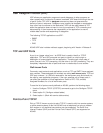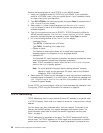xxx.xxx.xxx.xxx, where xxx is an integer between 0 and 255. The subnet mask is a
bit mask that determines which bits in the TCP/IP address designate the network
versus the host part of the address.
IP protocol works closely with the network and host portions of the address as well
as the subnet mask.
TCP/IP addressing reflects your licensing and networking needs. The size of your
network is the starting point for determining your TCP/IP addressing.
The following TCP/IP example is based on six existing networks you might have in
your company:
v Network 1 needs 100 IP addresses.
v Network 2 needs 90 IP addresses.
v Network 3 needs 40 IP addresses.
v Network 4 needs 50 IP addresses.
v Network 5 needs 50 IP addresses.
v Network 6 needs 50 IP addresses.
For this example, if you are going to use class C addressing, you need to have two
class C addresses. You could use Networks 1 and 2 for one class C address and
Networks 3, 4, 5, and 6 for the other class C address. This arrangement allows for
future expansion of the networks.
Continuing with this example, assume that the class C addresses are 192.1.1.x and
192.1.2.x. Here is how TCP/IP addressing could work in this example:
Network 1:
Network: 192.1.1.0
Subnet mask: 255.255.255.128
Usable range of IP addresses for hosts: 192.1.1.1 through
192.1.1.126.
Network 2:
Network: 192.1.1.128
Subnet mask: 255.255.255.128
Usable range of IP addresses for hosts: 192.1.1.129 through
192.1.1.254.
Network 3:
Network: 192.1.2.0
Subnet mask: 255.255.255.192
Usable range of IP addresses for hosts: 192.1.2.1 through
192.1.2.62.
Network 4:
Network: 192.1.2.64
Subnet mask: 255.255.255.192
Usable range of IP addresses for hosts: 192.1.2.65 through
192.1.2.126.
Network 5:
Network: 192.1.2.128
Subnet mask: 255.255.255.192
Usable range of IP addresses for hosts: 192.1.2.129 through
192.1.2.190.
Network 6:
Chapter 2. Configuring TCP/IP 25


















